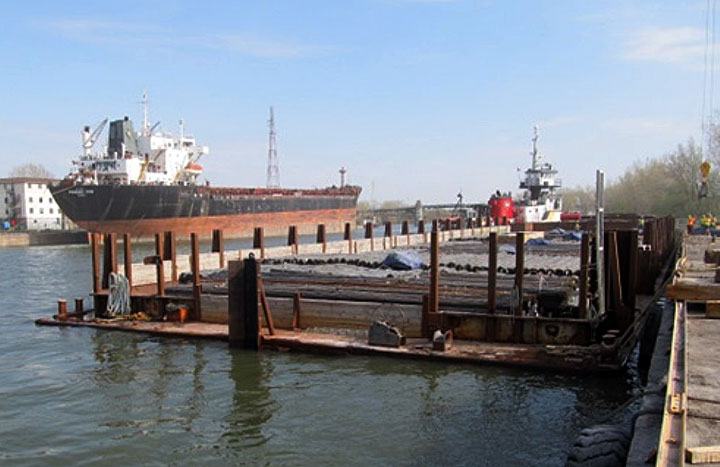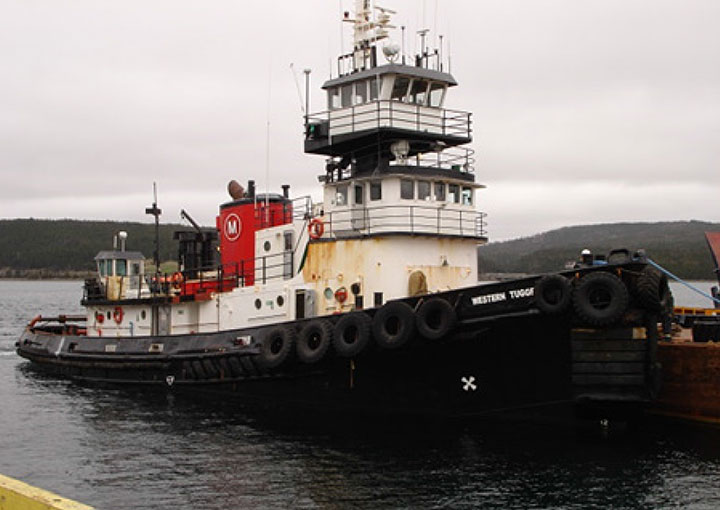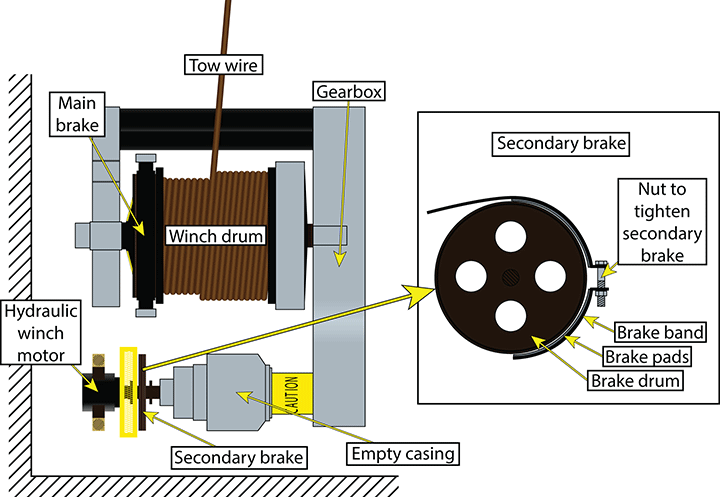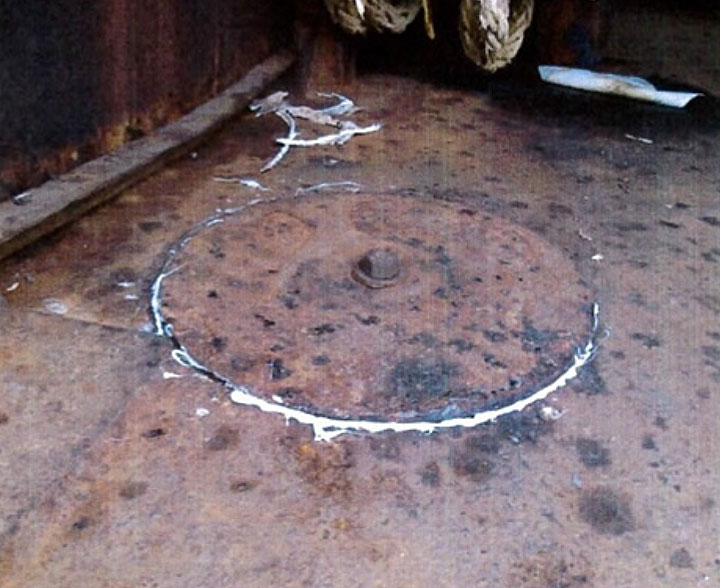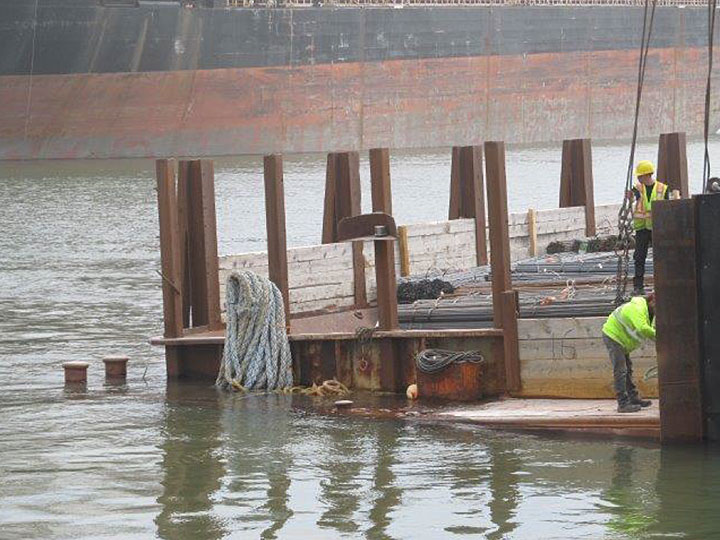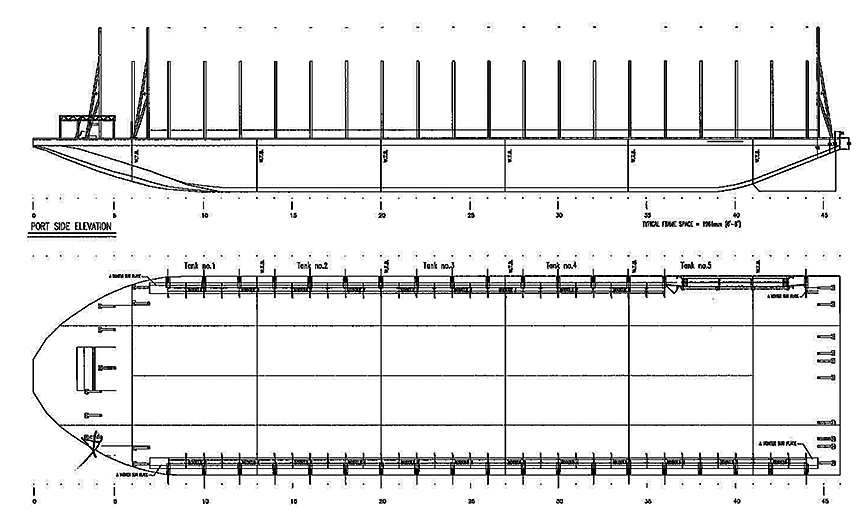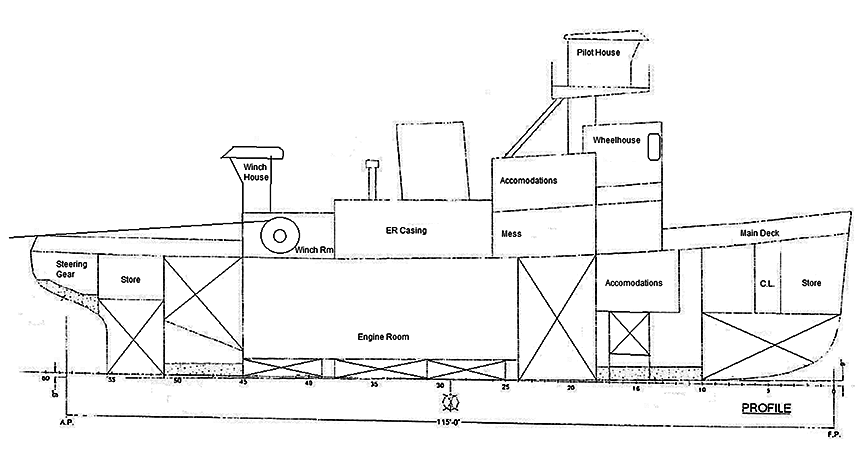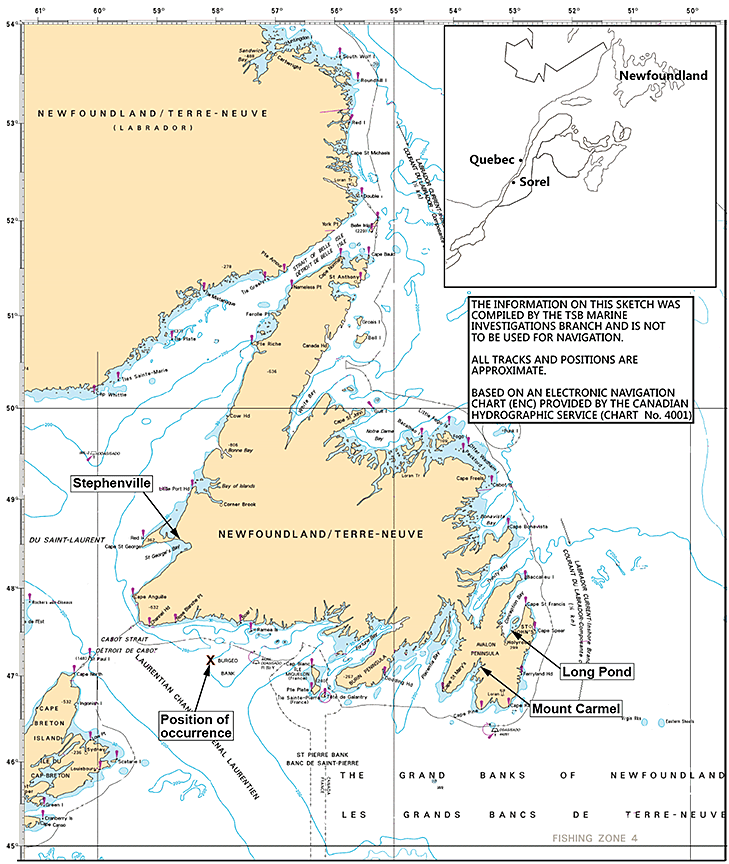Capsizing of tow and accidental death
Tug Western Tugger and barge Arctic Lift I
33 nautical miles southwest of Burgeo,
Newfoundland and Labrador
The Transportation Safety Board of Canada (TSB) investigated this occurrence for the purpose of advancing transportation safety. It is not the function of the Board to assign fault or determine civil or criminal liability. This report is not created for use in the context of legal, disciplinary or other proceedings. See Ownership and use of content. Masculine pronouns and position titles may be used to signify all genders to comply with the Canadian Transportation Accident Investigation and Safety Board Act (S.C. 1989, c. 3).
Summary
On 10 May 2013, at approximately 0625 Newfoundland and Labrador Daylight Time, the barge Arctic Lift I, which was carrying a cargo of steel rebar, capsized while under tow by the tug Western Tugger in moderate weather about 33 nautical miles southwest of Burgeo, Newfoundland and Labrador. The subsequent strain on the tow wire caused an auxiliary brake drum on the tow winch to shatter, and parts of it struck a crew member, who sustained fatal injuries.
Factual information
Particulars of the vessels
| Name of vessel | Western Tugger | Arctic Lift I |
|---|---|---|
| Official no. | 820322 | 820539 |
| Port of registry | St. John's, NL | St. John's, NL |
| Flag | Canada | Canada |
| Type | Tug | Barge |
| Gross tonnage | 389 | 2706 |
| LengthFootnote 1 | 35.4 m | 90.7 m |
| Draught at departure | Forward: 5.4 m Aft: 5.4 m |
Forward: 4.81 m Aft: 5.46 m |
| Built | 1943 in Oyster Bay, New York, US |
1972 in Houma, Louisiana, US |
| Propulsion | 1 diesel engine (1455 kW) | None |
| Cargo | None | 7095 tonnes of bundled steel rebar, ranging in length from 6 m to 17 m, and 40 tonnes of bundled wood |
| Crew | 8 | None |
| Registered owner | Midnight Marine Limited, St. John's, NL | Midnight Marine Limited, St. John's, NL |
Description of the vessels
Arctic Lift I
The barge Arctic Lift I, constructed of welded steel, was built in 1972 in the US (Photo 1). At the time, as per US regulations, it was assigned a load lineFootnote 2 by the American Bureau of Shipping. The vessel was sold to a Canadian owner and began operating in Canada in 1998. The current owner purchased and salvaged the barge after a previous occurrence had left it a constructive total loss in 2006.
The Arctic Lift I had no propulsion, was unmanned, and was not certified to carry dangerous goods; therefore, it was not required to undergo inspections by Transport Canada (TC), nor was it required to have a load line and load line certificate in Canada.
The hull is subdivided by 3 longitudinal bulkheads and 6 transverse bulkheads into 26 compartments (Appendix A). A steel bin-wall, 1 m in height, partially surrounds the barge. Each compartment has a hatch and an accompanying hatch cover. The hatch covers on the Arctic Lift I had been fabricated by the current owner to replace the original ones. The new covers were designed to be secured by a nut on the top of the hatch cover and by a dog underneath that could be tightened against the underside of the deck. The on-board practice for sealing the hatches was to apply a bead of household silicon around the perimeter of the hatch opening before securing the hatch down. Another bead of silicon was then applied around the exposed edge of the hatch cover.
Western Tugger
The Western Tugger is a coastal tug of steel construction that was built in 1943 and purchased by the current owner in 2007 (Photo 2). The vessel has a single propeller and rudder. The conning station, located in the wheelhouse that sits atop the deckhouse, is fitted with navigational equipment including radars, a very high frequency (VHF) radiotelephone, a global positioning system (GPS), an automatic identification system, an electronic chart plotter, and an autopilot. The deckhouse includes a galley, storerooms, and accommodations.
The Western Tugger was subject to regular inspections under TC inspection regulations. The vessel was certificated and equipped in accordance with existing regulations, and was last issued a safety inspection certificate (SIC 31) on 30 May 2012.
The towing winch is located in a winch room that is aft of the deckhouse on the main deck (Appendix B). The winch is operated from a winch house located directly above the winch room.Footnote 3 The towing wire on the winch at the time of the occurrence was 460 m long and 5.08 cm in diameter. The towing winch itself was equipped with a main air brake on the steel winch drum and a secondary air brake on the drive shaft (Figure 1). Because the winch drum had a tendency to slip while towing, even with both brakes applied, a nut-and-bolt assembly on the secondary brake was used to tighten the brake band and hold the winch drum in place. When the brakes were released, the winch drum would turn freely only if the nut-and-bolt assembly had been loosened.
The tug had an emergency tow release that was intended to allow an operator located in the wheelhouse to immediately release both air brakes; however, this function was overridden by the nut-and-bolt assembly on the secondary brake.
Brake design
Towing winches are commonly designed with an air brake that holds the winch drum in place, along with an emergency tow release that can be used to reduce tension on the tow line.Footnote 4 The emergency tow release is essential when there is excessive tension in the towline that could lead to the tug capsizing or being pulled down with the barge if it starts to sink. To apply the air brake, the drum is clutched in (to prevent the drum from slipping when the brake is applied). Once the air brake has been applied, the drum is clutched out, which allows the emergency tow release system (remote release of the air brake) to be activated when required.
On the Western Tugger, the main brake was unable to keep the winch drum from slipping while towing, even with the on-board practice of keeping the drum clutched in to the motor. For this reason, a secondary brake, which consisted of a brake drum on the drive shaft, had been installed.Footnote 5 However, these 2 brakes combined were still unable to keep the winch drum from slipping, so the on-board practice was to manually tighten the nut-and-bolt assembly on the brake band of the secondary brake in order to stop the winch drum from slipping.
Cargo loading
The tug and barge arrived in Sorel, Quebec, on 27 April 2013 to load steel rebar and bundled wood bound for Long Pond, Newfoundland and Labrador. This load would be the third that the tug and barge was to deliver to Long Pond; 2 prior deliveriesFootnote 6 had been made in October and December 2012.Footnote 7
Prior to loading the cargo for this voyage, the barge owner visually inspected the seals on the hatches. A bead of silicon was applied around selected hatch covers where the previously applied sealant had deteriorated (Photo 3).
Loading commenced on 29 April and involved fitting the bundled rebar of various lengths on the barge deck such that it was tightly and evenly packed. To keep the barge stabilized during loading, water was pumped in and out of tanks on the starboard side as required (Photo 4). The barge was loaded to a total weight of 7135 tonnes, a point at which the master and owner considered there to be adequate remaining freeboard and acceptable trim. Because the rebar was tightly packed to prevent movement, no lashings were used to secure it in place. When loading was complete, tarps were fastened over the cargo to protect it from the elements.
On 02 May, a cargo loading and stowage survey was carried out by a private surveyor at the request of the barge owner.Footnote 8 The purposes of the survey included determining the details of the load and stowage, reviewing the proposed voyage plan with the master of the Western Tugger, and providing recommendations and guidelines for the intended voyage. Specifically, regarding the vessel's load line, the surveyor recommended that the master “ensure that loaded barge does not exceed load line draft at amidships” (Appendix C). Although the barge had a load line marked from its earlier US registration, since no load line was required under Canadian regulations, there was no valid load line on the barge. The surveyor did not witness the loading of the cargo from the beginning, and the survey document stated: “It was reported that prior to barge loading, all compartments were opened up, inspected and confirmed that no water was present. All manholes were bolted and resealed after compartment inspection.” However, the TSB investigation determined that not all of the compartments had been checked for water prior to departure.
Upon completion of cargo loading, the surveyor determined that the barge was trimmed 106 cm by the stern, with measured freeboards of 122 cm forward and 15 cm aft. These numbers were agreed upon and signed off by the master, and a copy of the survey was sent to the vessel's owner.
History of the voyage
On 04 May, at approximately 0530,Footnote 9 the tug and barge departed Sorel. The voyage was expected to take 7 days at an average speed of 5 knots. The towing arrangement consisted of 2 wire bridles and a chain pennant fitted to the tow wire. The tow wire was paid out to 425 m once the tug and barge reached open sea, and about 1 m was paid out every 24 hours thereafter. Once underway, the crew, with the exception of 1 deckhand on day work, stood a watch of 6 hours on and 6 off.
The first 6 days of the voyage were uneventful, and the tug and barge proceeded on schedule. On 10 May at 0400, the mate on watch verified visually that the barge was towing normally.Footnote 10 Shortly after that, heavy fog rolled in, and the mate was unable to see the barge again during the watch. The master arrived on the bridge at about 0545, but was unable to see the barge. The mate left the bridge shortly after the master took over the watch.
At 0615, when the fog cleared somewhat, the master saw that the Arctic Lift I had acquired a large starboard list and immediately reduced power on the Western Tugger. The deckhand on watch with the master went to the winch room to loosen the nut used to tighten the secondary brake, and the second engineer stood by the winch controls to release them as required.
At about 0620, the bow of the barge rose out of the water and, as the barge capsized to starboard, the entire length of submerged tow wire was lifted out of the water. When the strain came on the winch, it shattered the secondary brake drum. Shards of the brake drum were projected into the forward area of the winch room and struck the deckhand.
The second engineer and other crew members were alerted by the loud noise of the drum shattering and immediately came to the aid of the deckhand. The crew administered first aid, while the master called Marine Communication and Traffic Services Port aux Basques to request medical assistance. The radio medical doctor recommended a helicopter medical evacuation for the patient. A search-and-rescue helicopter was on scene at about 0930, and the injured crew member was airlifted to the hospital in Stephenville, NL. However, the crew member died before arrival at the hospital.
After the capsizing of the barge, the master had the main winch drum seized with wire and shackles, and after consultation with the owner, began towing the overturned empty barge at about 2 knots toward Mount Carmel, NL,Footnote 11 where the company's marine base was located (Appendix D). On 12 May, due to worsening weather, the tug and barge sought refuge in Fortune Bay, NL. By 16 May, the weather had improved, and the Western Tugger and Arctic Lift I resumed the voyage, reaching Mount Carmel on 20 May.
Personnel certification and experience
The master held a master's certificate for vessels up to 500 gross tonnage engaged on near coastal voyages or tugs up to 3000 gross tonnage engaged on limited, contiguous-waters voyages. The master had initially obtained a master's certificate in 1985 and had worked for the current owner for approximately 6 years, serving as master on various vessels within the company. The master had served on the Western Tugger for the 2 previous voyages from Sorel to Long Pond.
The Western Tugger's crew were in possession of valid certificates for their positions and for the trade in which they were engaged.
Vessel operator
The company that owns the Western Tugger and the Arctic Lift I also operates a small fleet of tugs and barges primarily engaged in towing operations on Canada's east coast.
Environmental information
At the time of the occurrence, winds were from the southwest at 15 to 20 knots. The visibility was 1 mile in fog, and the seas were 2 m; the swell was 2 m from the south.
Damage to the vessels
When the secondary brake drum on the Western Tugger shattered, shards from the drum holed the deckhead and damaged the remote shut-off for the vessel's carbon dioxide extinguishing system. The shards also made dents and punctures in the winch room forward bulkhead and deckhead.
Following the occurrence, the barge remained overturned at the company's marine base. Given that the barge was overturned, only a cursory inspection was possible; this inspection revealed no apparent damage.
Stability assessment
A vessel's stability is determined in different states, both static and dynamic. Determining static stability involves calculating a vessel's stability at a given angle of keel, whereas dynamic stability takes into account external forces, such as wind and waves. Stability booklets are commonly used to assist operators in determining the limits of a vessel's intact and damaged stability; they also contain general information on stability principles and provide guidance to operators for maintaining the vessel's stability in various conditions (such as light, departure, and arrival conditions). The stability of any vessel is influenced by factors such as the shape of its hull, its freeboard,Footnote 12 and the amount and location of cargo loaded. Several factors may compromise a vessel's stability, including overloading, load shifting, damage to the hull, water ingress, environmental conditions, and external forces applied on the vessel (such as those exerted during towing). As a general principle, a vessel's stability decreases incrementally if the vessel rolls and the deck edge is submerged. An overloaded vessel will have reduced freeboard, which will cause its deck edge to submerge at smaller angles of heel.
In this occurrence, the Arctic Lift I had measured freeboards of approximately 122 cm forward and 15 cm aft in fresh water. Calculations by the Transportation Safety Board (TSB) determined that, given these freeboard measurements, the aft deck edge would be submerged at a 1° roll, or in a 0.15 m sea. When the barge entered salt water, the freeboard would have increased to 132 cm forward and 25 cm aft. Aft deck edge immersion would have occurred at 1.3° roll, or in a 0.25 m sea.
The Arctic Lift I did not have a stability booklet, nor was one required by regulation.
Regulatory regime
TC currently has standards and requirements specific to tugs and to self-propelled, manned and oil carrying barges, but it does not regulate unmanned barges such as the Arctic Lift I. In 2005, TC formed a Tug and Barge Working GroupFootnote 13 to address the need for Canadian standards and requirements with respect to the construction and operation of tug–barge combination systems. In 2006, the working group presented a report to the Canadian Marine Advisory Council (CMAC), identifying several gaps in the regulatory scheme of the tug-and-barge industry. Issues identified relate to this occurrence in the following areas:
- The absence of inspection requirements for general cargo barges,
- The need for all barges to have a load line representing the “maximum immersion for both summer and winter conditions,”Footnote 14 and,
- In general, a lack of construction standards for the majority of barges.Footnote 15
Thus far, no new standards or requirements have been implemented as a result of the Tug and Barge Working Group's findings. The group met again in the spring of 2014.
To assist Canadian towing operators, TC advises that they “should use, where appropriate, the annexed International Maritime Organization (IMO) recommendations to supplement Canadian towing measures.”Footnote 16 The IMO annex, Safety of Towed Ships and Other Floating Objects, has several recommendations for operators, including the following:
- Prior to sailing, the watertight integrity of the tow should be confirmed by an inspection of the closing arrangements for all hatches, valves, air pipes, and other openings through which water might enter.
- The securing arrangements and weather protection for the cargo, equipment, and stores carried on the tow should be carefully examined to ensure that they are adequate for the voyage.
- The tow should be at a suitable draught for the intended voyage.
- The tow should have adequate intact stability in all of the loading and ballast conditions to be used during the voyage.
Safety management system
An effective safety management provides a formal framework for identifying and mitigating risk. Ideally, a vessel operator would identify existing and potential risks, establish safety policies and procedures to mitigate the risks, and then provide a means to continuously gauge effectiveness so as to improve organizational safety where necessary. The resulting documented, systematic approach helps to ensure that individuals at all levels of an organization have the knowledge and the tools needed, as well as the necessary information, to make sound decisions in any operating condition, including both routine and emergency operations.
In 2012, the TSB released an updated edition of its 2010 Watchlist. This document identifies the 9 safety issues that pose the greatest risk to Canadians and Canada's transportation system. One issue on the Watchlist is marine safety management systems (SMS). Specifically, the Board has pointed out that TC does not always provide effective oversight of marine transportation companies that develop and implement an SMS, and that some companies are not required to have one. The TSB has repeatedly emphasized the advantages of having an SMS in the marine industry, citing issues related to SMSs in many occurrences over the last 14 years.Footnote 17 TC has proposed new Safety Management Regulations that, once implemented, will require an SMS for all vessels that are greater than 500 gross registered tons (GRT), that have a length of greater than 24 m, or that are carrying more than 50 passengers.
Although the benefits of SMS have long been recognized by the marine community, SMS is not required on all types of vessels. Operators, however, are encouraged by TC to implement one. The Western Tugger is not a vessel engaged in international trade and, as such, is not subject to the International Convention on the Safety of Life at Sea or the International Safety Management Code for the Safe Operation of Ships and for Pollution Prevention, and does not require an SMS. Despite not being required to do so, the company was working toward implementing a certified SMS, including risk assessments and safe work practices; however, the SMS was not in place at the time of the occurrence. The company did have a health and safety manual on board, but the manual did not include risk assessments or safe work practices for tug operations.
Previous occurrences
On 29 October 2006, the barge Arctic Lift I, then known as OTM 3072, was carrying a cargo of bulk wood chips and was under tow by the tug Ocean Foxtrot when it capsized while in a strong gale about 6 nautical miles (nm) north of Bas-Caraquet, New Brunswick. There were no injuries, but the barge was declared a constructive total loss.Footnote 18 No stability calculations had been made for the barge prior to departure, the OTM 3072 was regularly loaded to the extent that the load line was submerged, and the stability of the barge was a factor in the capsizing.
Between 1998 and 2013, there were 27 capsizings (including this occurrence) involving barges reported to the TSB. The majority of these were due to 1 or more of the following factors:
- limited transverse stability resulting from improper loading,
- a loss of transverse stability in rough weather,
- downflooding of 1 or more of the watertight compartments, and
- improper cargo stowage.
According to TC's Vessel Registration Query System, as of 2013, there were 1280 barges with a tonnage exceeding 100 registered in Canada.
Analysis
Events leading to the capsizing and fatality
On 10 May, the Arctic Lift I developed a large list while being towed by the Western Tugger. This list may have been the result of several factors. Given the barge's minimal freeboard, the aft deck edge was frequently submerged, allowing water to be shipped on deck. Shipped water may have created a free surface effectFootnote 19 on deck and may have downflooded through hatches that were not adequately sealed, creating a free surface effect within the compartments as well. It is also possible that the list occurred because the barge was damaged en route, resulting in water ingress, or because the unsecured cargo had shifted, affecting the barge's stability.
Although the vessel had an emergency tow release, it could not be activated from the wheelhouse due to the nut-and-bolt assembly on the secondary brake. As such, the master requested that the deckhand go to the winch room and stand by to loosen the nut. Moments later, the forward end of the barge rose out of the water and the barge capsized. The resulting strain on the secondary brake drum caused it to shatter, and parts of it hit and fatally injured the deckhand.
Barge stability
On barges that are unmanned (where no one is on board to check for water ingress) and unmonitored (where no alarms are present to detect water ingress), conditions threatening stability may not be readily detected.
On the Arctic Lift I, the extent to which the barge was loaded was based primarily on informal assessments and on prior experience of loading this barge by the master and owner, with consideration to the assessment by the cargo surveyor. The primary purpose of the surveyor was to determine the details of the load and stowage of the cargo; the secondary purpose was to provide recommendations and guidelines for the intended voyage. The cargo surveyor had recommended that the load line not be submerged (Appendix C). However, the load line was not observed by the surveyor. The surveyor's recommendations were general in nature.
Furthermore, the load line marked on the vessel was not valid. The load line had initially been assigned to the barge when it was sailing in American waters, and there was no requirement for it to have a load line or a load line certificate in Canada. Also, when it was salvaged in 2006 by the owner, any modifications made to the barge after the issuance of the existing load line would have necessitated a reassessment to determine a new load line.
The responsibility for ensuring safety and stability is that of the master and owner. The assessments drew upon a freeboard and trim that they had determined to be acceptable through previous voyages, but did not account for how the vessel's stability and loaded condition would be affected by the environmental conditions likely to be encountered on the voyage. Furthermore, these assessments could not be verified without the guidance of a stability booklet. In addition, the Transportation Safety Board (TSB) investigation determined that not all of the compartments had been checked for water prior to departure.
If an assessment of a vessel's stability and its loaded condition does not take into account the environmental conditions likely to be encountered on the voyage, there is a risk of the vessel being unfit for the intended voyage.
Emergency tow release
Hazards associated with towing operations may include girding,Footnote 20 capsizing, or sinking of the tow; any one of these situations puts the towing vessel at risk. As required by the Hull Construction Regulations, towing vessels are required to be fitted with an emergency tow release that can be operated immediately from the steering position(s).Footnote 21
The remote release on the Western Tugger was unable to function as intended because of the nut-and-bolt assembly on the secondary brake drum. The installation of a nut-and-bolt assembly required a crew member to enter the winch room and manually loosen the nut before the winch drum would pay out the tow wire, rendering the emergency tow release ineffective. This practice introduced a hazard to operations, which was not identified or mitigated.
Furthermore, following the capsizing, the main winch drum was intentionally seized in order for the barge to be towed back to the company's marine base. While the barge was overturned and at sea, a comprehensive assessment of damage was not possible; yet the intentional seizing of the winch meant that the emergency tow release could not be used in the event that the barge sank en route.
If a tug's emergency tow release cannot be activated immediately, the vessel and its crew are at increased risk during an emergency.
Safety management system
An effective safety management system (SMS) requires organizations to recognize the risks involved in their operations and to competently manage those risks. SMSs involve a formal, documented, and systemic approach that includes a commitment from senior management, as well as a rigorous risk assessment process and a means to continuously gauge effectiveness so that improvements can be made where necessary. The resulting system helps ensure that individuals at all levels of an organization have the knowledge and tools to effectively manage risk, as well as the necessary information to make sound decisions in any operating condition. While safety management systems are widely recognized as effective methods for assessing risk in the marine sector, they are not required on all vessels.
On the Western Tugger, although an SMS was under development, it had not been implemented before the occurrence. Had a formal risk assessment process been in place, it might have identified the following potential hazards prior to sailing:
- an emergency tow release that was not capable of being operated immediately,
- hatches that were not reliably watertight,
- minimal freeboard, and
- cargo that was unsecured.
Given that the tug and barge had made successful voyages under similar conditions, it is possible that these risks had become normalized through repetition and that, with the completion of each successful voyage, the perception of the severity of each risk had decreased.Footnote 22,Footnote 23
If a vessel operator does not have a safety management system that includes a process for ongoing risk assessments, there is an increased risk that operational hazards will not be identified and mitigating measures will not be proactively implemented.
Regulatory regime
Tug and barge operations represent a significant part of Canada's transportation industry. While some of these barges (self-propelled, manned, and those carrying oil) are regulated by Transport Canada (TC), others, such as the Arctic Lift I, fall outside of the current regulatory framework. The Tug and Barge Working Group was formed to address issues such as the absence of inspection requirements for general cargo barges, the absence of load lines on barges, and the lack of construction standards for the majority of barges.
The Arctic Lift I was not required to undergo any inspection, demonstrate that it met minimum stability standards, have marked load lines, or hold a load line certificate. In contrast, these are requirements for US barges. Although the Tug and Barge Working Group presented several of these issues to the Canadian Marine Advisory Council in 2006, further requirements for unmanned barges have not yet been developed.
As demonstrated in this occurrence, there is a risk that a barge that falls outside of regulations may be overloaded due to the absence of a legitimate load line or may not have watertight hatches, which increases the risk of capsizing. Therefore, if certain types of unmanned barges in Canada continue to operate outside a regulatory framework, there is a risk of these vessels being operated beyond their structural and stability limits.
Findings
Findings as to causes and contributing factors
- The barge developed a list to starboard due to one or a combination of the following factors: water shipped on deck, water ingress, free surface effect, and shifting of cargo.
- The barge was loaded with unsecured cargo and to an extent that caused the vessel to have minimal freeboard.
- The emergency tow release was prevented from operating by a nut-and-bolt assembly.
- The company's assessments of risks and safe work practices did not identify or mitigate the potential hazard associated with the installation of the nut-and-bolt assembly on the secondary brake and the requirement that it be manually released in an emergency.
- The deckhand entered the winch room to release the nut-and-bolt assembly, and when the barge capsized, the sudden strain on the tow wire caused the secondary brake drum to shatter, projecting shards into the winch room that fatally injured the deckhand.
Findings as to risk
- If an assessment of a vessel's stability and its loaded condition does not take into account the environmental conditions likely to be encountered on the voyage, there is a risk of the vessel being unfit for the intended voyage.
- If a tug's emergency tow release cannot be activated immediately, the vessel and its crew are at increased risk during an emergency.
- If a vessel operator does not have a safety management system that includes a process for ongoing risk assessments, there is an increased risk that operational hazards will not be identified and mitigating measures will not be proactively implemented.
- If certain types of unmanned barges in Canada continue to operate outside of a regulatory framework, there is a risk of these vessels being operated beyond their structural and stability limits.
Safety action
Safety action taken
Transport Canada
Transport Canada is currently consulting on the expansion of the Safety Management Regulations. Under the current proposal, the Western Tugger would be required to have a safety management system in accordance with the International Safety Management Code.
Vessel operator
The vessel operator is repairing the vessel's towing winch, which will not incorporate a second brake.
This report concludes the Transportation Safety Board's investigation into this occurrence. The Board authorized the release of this report on . It was officially released on .
Appendices
Appendix A – Arctic Lift I general arrangement
Appendix B – Profile of the Western Tugger
Appendix C – Towing recommendations issued by the surveyor
The barge is to be towed from Sorel, Quebec to Long Pond, Newfoundland and Labrador within the coastal limits on the East Coast of Canada. The following general points are to be followed:
General Recommendations for the Barge:
- Master to ensure that loaded barge does not exceed loadline draft at amidships.
- Barge compartments to be maintained free of water unless specifically required to level barge transversely and maintain appropriate trim. Slack tanks are to be avoided.
- Barge anchor and ramps to be secured for the voyage, with the provision that the anchor on the barge may be released in an emergency.
- All bollards and bitts to be kept clear of obstructions.
- Sufficient mooring lines to be ready for use, fore and aft.
- All loose gear to be properly stowed, lashed, and secured to the satisfaction of the attending Surveyor.
- Cargo to be stowed on the deck, with weight distributed, so that the barge is slightly trimmed by the stern, with negligible list to port or starboard. A cargo manifest is to be provided, prior to commencement of loading.
- Cargo to be stowed and secured to the satisfaction of the attending Surveyor.
- Navigation lights to comply with International and local regulations. If required, a daytime towing signal is to be displayed.
- Means to be provided for boarding the barge.
- At least one suitable, portable pump is to be available, with sufficient fuel, hoses, and connections to discharge any given barge compartment.
- Barge to be fitted with bitts/towing pads of adequate strength for the intended tow. The main towing arrangement to be available for examination by the attending Surveyor, and such arrangements to be discussed and agreed to, with Owners and Tug Master.
- Tow bridle, connections and tow wire to be monitored by vessel master and any deficiencies rectified.
- The tow is to be rigged with an emergency towline with floating messenger line.
- Tow line, bridle, and securing arrangements to be adequately protected against chafing.
General Requirements Towing Vessel:
- The master of the tug shall maintain regular contact with Coast guard radio station and shall report position, speed made good, and weather conditions to owner.
- Sufficient fuel, lubricants, water and supplies to be on board for the intended voyage, with an adequate safety margin.
- A full set of the necessary charts and publications required for the voyage to be on board and corrected to the latest Notices to Mariners. Navigational equipment to be sufficient and operational.
- All lifesaving and firefighting equipment to be available for immediate use in accordance with regulations.
- Tug to be adequately manned and staffed with personnel having the required certificates of competency as per Safe Manning Regulations.
- The final towing arrangements to be discussed and agreed to between the Owners, Tug Master, and the attending Surveyor prior to departure.
General Voyage Recommendations:
- The master is to wait for a favorable weather forecast which includes a weather window of at least 12 hours before proceeding from a port of refuge. Also, frequent weather forecasts to be obtained enroute. Early consideration should be given to altering course and/or seeking shelter to avoid forecasted bad weather.
- The master is to choose a route that affords a port of refuge at least every 50 nautical miles.
- The tow is not to be undertaken in winds over 24 knots or in sea conditions over five feet significant wave height.
- International, federal, and local regulations to be observed and complied with, traffic routing schemes, pilotage, navigation lights and shapes, etc.
- The general routing of the tow to be discussed and agreed to by the Master and the attending Surveyor.
- Bunker consumption to be closely monitored during passage and arranged so that the tug has an adequate reserve of fuel at all times during the voyage.
- Speed of the tow to be at the Master's discretion, but excessive pounding of the barge is to be avoided at all times.
- At the completion of the tow, the master is to inform the surveyor when the tow is secured at the port of destination.
Appendix D – Area of the occurrence
Source of inset map: Brock University Map, Data & GIS Library, St. Catherines, Ontario, 2001. http://www.brocku.ca/maplibrary/maps/outline/local/stcathDT.jpg, last accessed 21 January 2014. Modifications and labels added by TSB.
